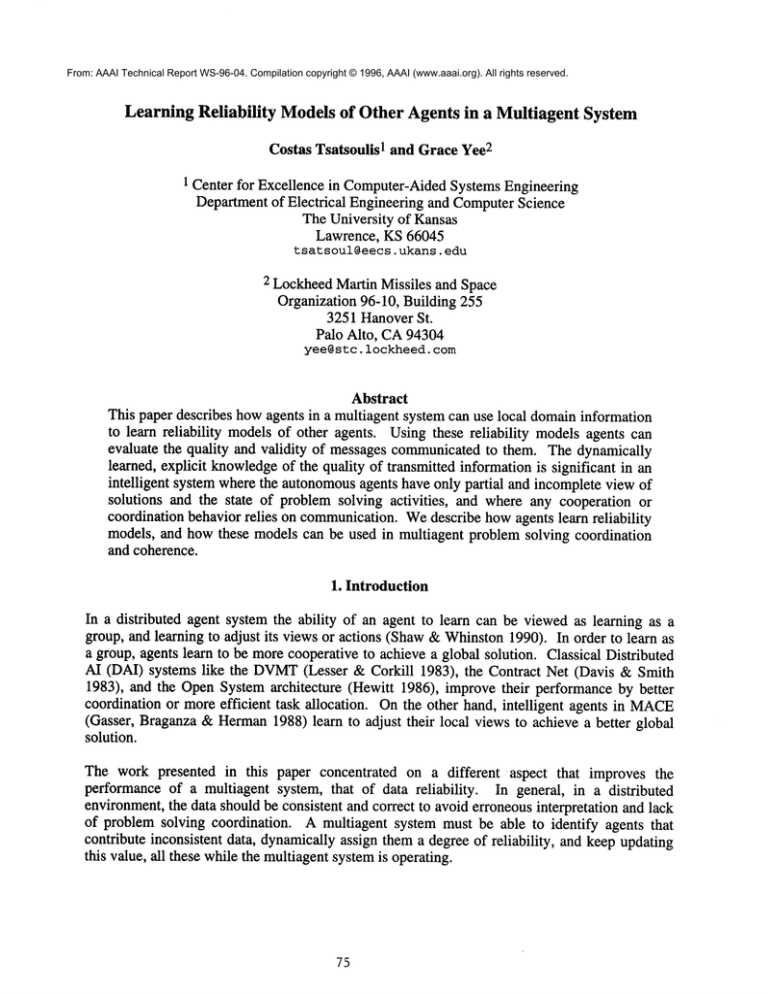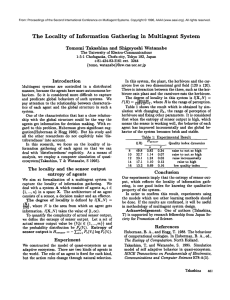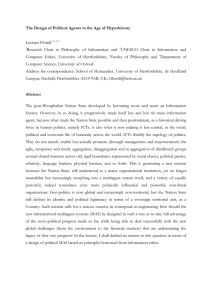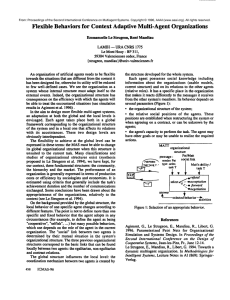
From: AAAI Technical Report WS-96-04. Compilation copyright © 1996, AAAI (www.aaai.org). All rights reserved.
Learning Reliability Modelsof Other Agents in a Multiagent System
Costas Tsatsoulis 1 2and Grace Yee
1
Center for Excellence in Computer-AidedSystems Engineering
Departmentof Electrical Engineering and ComputerScience
The University of Kansas
Lawrence, KS 66045
tsatsoul@eecs, ukans, edu
2
LockheedMartin Missiles and Space
Organization 96-10, Building 255
3251 Hanover St.
Palo Alto, CA94304
yee@stc, lockheed, com
Abstract
This paper describes howagents in a multiagent system can use local domaininformation
to learn reliability models of other agents. Using these reliability modelsagents can
evaluate the quality and validity of messages communicatedto them. The dynamically
learned, explicit knowledgeof the quality of transmitted information is significant in an
intelligent system where the autonomousagents have only partial and incomplete view of
solutions and the state of problem solving activities, and where any cooperation or
coordination behavior relies on communication.Wedescribe howagents learn reliability
models, and howthese models can be used in multiagent problem solving coordination
and coherence.
1. Introduction
In a distributed agent system the ability of an agent to learn can be viewedas learning as a
group, and learning to adjust its views or actions (Shaw& Whinston1990). In order to learn
a group, agents learn to be morecooperative to achieve a global solution. Classical Distributed
AI (DAI) systems like the DVMT
(Lesser & Corkill 1983), the Contract Net (Davis &
1983), and the OpenSystem architecture (Hewitt 1986), improve their performance by better
coordination or moreefficient task allocation. Onthe other hand, intelligent agents in MACE
(Gasser, Braganza & Herman1988) learn to adjust their local views to achieve a better global
solution.
The work presented in this paper concentrated on a different aspect that improves the
performance of a multiagent system, that of data reliability.
In general, in a distributed
environment,the data should be consistent and correct to avoid erroneous interpretation and lack
of problem solving coordination. A multiagent system must be able to identify agents that
contribute inconsistent data, dynamicallyassign thema degree of reliability, and keep updating
this value, all these while the multiagentsystemis operating.
75
Becauseof the need for coordination, DAIsystems are facing moreconflicts and inconsistencies
then stand-alone systems. Most blackboard frameworks have disparity problems when nodes
interpret the global data differently (Ermanet al. 1980; Durfee & Lesser 1988). In the DVMT,
network nodes conflict because they only have partial viewpoints of the world (Durfee & Lesser
1987; Durfee & Lesser 1991). In RESUNand DRESUN
(Carver, Cvetanovic & Lesser 1991)
the possibility of alternative explanations of data can result in contradicting hypotheses.
Knowledgebase incompatibilities can also induce inconsistencies (Lenat 1975).
Wehave developed a new approach to the problem of learning to deal with inconsistent data.
Our approach concentrates on the communicationbetween agents, and our systems learn to
inhibit or allow inter-agent messagepassing based on probabilities. Our system is called the
EACCS,Error Adaptation CommunicationControl System, and it helps agents learn to avoid
erroneous data, thus optimizing the global problemsolving process.
The EACCS
is composedof three main components: a dependency trace, a blame assignment
mechanism,and a contradiction resolution algorithm. The dependencytrace keeps track of the
path of a received message,including both the source of the messageand the reasoning that led
to it. The blame assignment mechanismassigns blame to the paths supplying inconsistent data,
and is the major learning component that designates reliability
values to the agents
communicatingdata. The contradiction resolution algorithm chooses betweenany contradicting
information received by an agent. With these three features, an agent in EACCSbuilds a
dynamic reliability
model of its neighbors which help it resolve both local and global
inconsistencies.
2. Data Inconsistency in Multiagent Systems
In a multiagent system messagescomefrom two different sources: facts generated from the local
problemsolving agent (the internal facts), and facts received from the neighboring agents (the
external facts). Three types of inconsistencies arise in a multiagent system: inconsistencies
involving only internally deduced facts, inconsistencies involving both external and internal
facts, and inconsistencies involving only external facts (Bridgeland &Huhns1990). In our work
we treat all three inconsistencies similarly: since internally deduced facts are supported by
external facts, all inconsistencies can be expressed as type 3 errors, i.e. conflicts between
I.
externally receivedfacts
Wepropose a new classification of data inconsistency in multiagent systems: sensor errors,
knowledgebase errors, and communicationlink errors.
As a "sensor" we define any process that provides the multiagent system with input data. A
sensor can be an actual real-time environmentsensing device or a user. A sensor is assumedto
1 Weare assumingthat an agent believes completely in the correctness of its problem solving knowledge, thus it
will always assumethat incorrect or inconsistent inferences are the result of erroneous data that was received from
outside sources.
76
generate or collect a certain class or classes of facts. Wedefine a sensor error as the generation
of a datumfromanother class of facts.
Knowledgebase errors arise from an incomplete or overlapping knowledgebase. In a rulebased system an overlapping knowledge base can be caused contradiction, subsumption and
redundancy in rules. Subsuming and redundant rules only induce inefficiency,
while
contradicting rules produceinconsistencies.
Communicationerrors arise from unreliable communicationchannels. Data are corrupted when
the content is changed during transmission. Redundant information and communication are
traditionally used to recreate the lost and corrupted messages(Lesser & Erman1980).
I~
CLIPS Expert
System
Rule Base )
Rules
essages
~MSend
S1
~._(Multi.Agent
1
Messages
l Receive
Communications Tool
s2~
8rn
j_,
~.~-A
1
A2
v
A
n
Figure 1: Architecture of an agent
3. Structure of a Multiagent System
In our system an "agent" consists of three parts, as shownin Figure 1. The top level of an agent
is its problem solving component, implementedas a CLIPSrule base in our experiments. The
77
lowest level is the communicationscomponentwhich deals with the receipt and transmission of
messages. The intermediate component, and the one on which this paper concentrates, is the
EACCS,which determines data inconsistencies, learns reliability models, and resolves data
inconsistencies based on these models.
A sensor is a simple agent whichonly collects or produces a class or classes of facts, and then
communicatesthem. This implies that facts are grouped into classes which are recognizable by
all agents. This common
vocabulary is important for learning, since conclusions madeabout a
single datumare rarely useful unless they can be extended to the larger class to which the datum
belongs. Figure 2 showssuch a sensor.
Fact Generator
~
Send
Messages
)
~Reeeive
/Messages
IMulti’AgentC°mmunicati°nsT°°ll~AA12
A
n
Figure 2: Architecture of a sensor
The multiagent system consists of agents and sensors, connected by communication lines.
Figure 3 showssuch a system. Our representational convention is that agents, i.e. the problem
solving componentsof the system, are represented by ovals, while sensors are represented by
rectangles. Note that only the agents directly connected to a sensor have access to it; other
agents need to have sensor information routed to them through other membersof the multiagent
system.
,
Figure 3: An example multiagent system
78
T
4. LearningReliability Modelsin a Multiagent System
Traditionally, a fact is believed if its supportingjustifications are believed. This requires either a
fundamental fact or circular arguments to ground the beliefs (Doyle 1979). Distributed Truth
Maintenance Systems support incomplete and non-monotonic reasoning by incremental
consistency checking and labeling and by managementof a shared datum labeling (Huhns
Bridgeland1991), or by sharing partial results to retain overall consistency in the data labelings
(Mason1988). To implementsuch truth maintenance in a multiagent system requires that every
agent has complete knowledgeof all facts in the system or that all partial results are shared
betweenall agents, both restricting assumptions. The goal of a distributed truth maintenance
system is to maintain a consistent world upon every interaction; our goal is to accept
inconsistency as unavoidable and to allow the multiagent system to learn howto react to it and
howto resolve it. To do this in the EACCS
we take a different view of the validity of a fact: all
facts are assumed to be believed without reason. Wheninconsistencies arise, neither of the
contradictory facts has groundknowledgeto support it; thus, the agent disbelieves all of them.
The inconsistency is resolved by the reliability model, a model that each agent learns and
modifies dynamically.
The reliability modelis a probabilistic modelthat leads an agent to believe a fact "more"than a
contradictory one. This implies that the EACCSmust first identify when two facts are
contradictory and then to build the reliability modelof the sensors and agents that transmit data
that cause contradictions.
4.1. Identifying Contradictions
Contradicting facts are facts that cannot co-exist at the sametime in the samesystem, and, both
facts must be part of the problem solving2. In a real-time environment, a fact can be valid at
certain times and incorrect in other periods. For example,the direction of a vehicle maychange
over time, and the existence of two different vehicle directions in the samedatabase is not
necessarily an error. Onthe other hand, a vehicle cannot have two different directions within
some At, and the existence of such facts would indicate a data inconsistency. The EACCS
componentof an agent uses domain-constraint knowledgeto restrict the facts that can co-exist
in that agent in a windowof time and to recognize whenthe multiagent system is attempting to
solve problems in two different, contradicting contexts. The domain-constraint knowledge
knowsabout contradicting solution paths and will identify such inconsistencies. For example,
suppose that based on sensor inputs, one agent identified an airplane as enemyand planned
hostile actions. At the same time, another sensor supplied information that the airplane is
friendly; based on this sensor, someother agents follow a "friendly" problemsolving context.
This will lead to a failure whensomeagent in the system receives facts generated by the two
contradictory solution contexts.
4.2. Learning and UpdatingReliability Models
To recover from inconsistent information an agent has to develop a mechanismto deal with the
agents that transmit data that cause contradictions. However,the agent which generates the
inconsistency maynot be the one responsible for the corrupted data, since its reasoning maybe
2 If a fact doesnot contributeto the problem
solvingactivities of an agent,thenweassume
that the agentis not
concerned
withthe fact’svalidity.
79
soundbut based on erroneous information it received. Thus, an agent has to trace back to all the
agents supplying data or justifications that led to the inconsistencies. Since the inconsistencies
arise fromerroneousdata affecting a small portion of the’ belief space (i.e. it is morelikely that
the valid fact of the contradicting pair is moreconsistent with the worldthan the erroneousone),
we can use probability to lower the belief in the agents providing these data. As the agents
establish a reliability modelof their neighbors, the systemcan isolate the error-generating agents
without harmingthe overall problemsolving.
Anagent records all incoming messages, including both the supporting justifications and the
sources. Using its domain-constraint knowledgeit checks for the validity of all incoming
messages. Whenconflicts arise, the agent stops its problemsolving, traces back, and takes off
reliability credits from the agents responsible. Anagent will only lower the reliability in the
erroneous fact class received by an agent, allowing the reliability of other facts received from
this agent to remain unaffected. All these operations are performed by the Error Adaptation
Communication Control System, the EACCS.
The EACCS
consists of three main components: the dependency trace, the blame assignment
mechanismand the contradiction resolution algorithm.
The dependencytrace helps an agent keep track of all incoming messages and their sources.
This structure includes the source of a message,that is, the agent whichtransmitted the fact, and
a list of all justifications, the facts supporting the one transmitted. Since there is no groundfact
to support any of the data, all the antecedents of the facts maybe involved in the inconsistent
data. Thus, we have to record the wholepath history of all justifications, from the beginning of
the sensor sampling. Following is the format of a received message:
A
(C3 (Assert0.0"v02"v022(C’)vI4(S C’)v717
Receiving
Agent
Sending Agent
Priority
~1of
of ItInference
Action
Index
Cost
ce Agent
Contents
Routing Agent
Figure 4: Messageformat
Notes about the message:
¯ The message has an Action denoting the procedure that the Receiving agent should take. An
Action can be Assert, Send, Sample,etc. It also has a priority value, used whenstoring incoming
messages in the agent’s priority first-in-first-out
queue, and a cost value representing how
expensiveit was to generate and route the message(see (Kinney1992) for detail).
¯ The message contains the complete path of the information. Whenever inferencing is
performed,the "level of inference" is incremented.
8O
¯ RoutingAgentis the agent that routes the fact to another agent but is not responsible for its
generation.
The messageof Figure 4 meansa fact of class v7 and Fact ID 1 is generated from sensor T and
is routed to agent B and from there to C. Anotherfact of class v 1 and Fact ID 1 is sampledfrom
sensor S and is also routed to agent C. Agent C uses these two facts to fire a rule which
generates a new fact with class v0 and Fact ID 2. Finally, fact 2 was sent to agent A with
priority 3, and the actual fact wasasserted in the rule base of agent A.
In large multiagent systems the dependency trace may become very long, and the
communication bandwidth needed will overwhelmthe system. To avoid this the user of the
system can define a threshold that will limit the length of the dependencypath inside the
message. This maydegrade the perfrormance of the reliability algorithm, but allows the EACCS
to scale up well.
After a fact is received, the domain-constraintknowledgechecks the consistency of this fact with
the other data knownby the agent. If a fact generates an inconsistency, the EACCS
activates its
blame assignment mechanismand updates its reliability models.
Since there are no groundfacts to support any of the reasoning, both of the contradicting facts
have equal probability of being wrong; in fact, the whole antecedent paths of both facts are
suspected. Thereceiving agent will first retract all suspected facts, and then retract reliability
credit from all the agents involved in generating the message.The reliability credit, or simply
the RC, is a degree of trust an agent should showtowards fact classes received by other agents.
Each agent has a table of RCvalues for all the neighbors for all fact classes. Figure 5 showsa
piece of such an RCtable held by an agent.
Agent A
Agent B
Agent C
Fact Class 1
1
0.8
1
Fact Class 2
0
1
0.9
Fact Class 3
0.6
1
0.1
Figure5: Table with reliability credits.
Obviouslyour approachis sensitive to the classification of facts, since a single, consistently
erroneous fact wouldlower the reliability of a whole class. Having manysmall classes helps
avoid penalizing too manyfacts at the sametime. Onthe other hand, manyclasses increase the
size of the reliability table stored and maintained by an agent, thus increasing memoryand
computing requirements.
Reliability credit values range from [0,1 ], where"0" meansthat a fact of this class received from
a particular agent is never trusted and believed, while "1" denotes a totally reliable fact class.
So, in the table of Figure 5, a fact belonging to class 2 and received from agent Awill never be
believed.
81
Initially, whenthe multiagent system is first activated, all RCvalues are 1, since no agent has
received contradictory information. Whena contradiction is identified, suspected agents have
their RCreduced. The RCvalue is decreased by the following equation:
ARCr(a,b) = RCr(a,b ) r x
1
where:
ARCT(a,b)
is the changein the reliability credit of class T transmitted fromagent a to
RSbis the rule base size of agent b;
TPTis the normalizedtransmission path length of class T.
In other words, the RCis decremented inversely proportionally to the rule base size of the
receiving agent, since the larger the rule base size the easier it is for an agent to produce
contradicting facts. Note also that we use the normalized length of the transmission chain
defined as the transmission length to an agent in the path divided by the total path length3. The
assumptionis that the agents deeper in the transmission path are morelikely to be the causes of
the inconsistent data, since, otherwise, the error should have been detected earlier. At the same
time, we do not completely absolve agents early in the path, since it is possible that their
domain-constraint knowledgesimply failed to identify the inconsistency.
Note that reliability cannot be restored in our current methodological formulation. One-time
errors, though, will not affect the system greatly, since the equation is not sensitive to single
errors. Somepenalty will be applied, but it takes manyinconsistencies generated by the same
agent or path to impactthe reliability credit substantially.
4.3. Resolving Contradictions
After an inconsistency is detected, the agent must decide which of the contradicting facts to
believe and use. If the RCvalue of one fact is above a maximum
threshold and the other one
belowa minimum
one, this implies that one fact can be trusted while the other one is unreliable.
The agent will then penalize the path submitting the unreliable fact. In any other case (if the RC
values of both facts are below the minimumthreshold or above the maximumone, or one of
them is betweenthe maximum
and the minimum
thresholds) it implies that both facts are either
too unreliable or too reliable. In either case both data are disbelieved and discarded, and both
paths supplying them are penalized and have their RCvalues reduced.
5. ExperimentalResults
Weran experiments of the EACCS
on various multiagent architectures using different values for
the probability of failure of a sensor, an agent, and a communications link. Since we
concentrated on studying the experimental performance of our model, we did not use any real
domainknowledge. Our systems contained randomlygenerated rule-based and sensors.
3 A fact transmitted by a sensor is assumedto have transmission path length of 1.
82
Our results have shownthat the system is able to identify and isolate the source of error.
Interestingly, the larger the probability of error, the faster the system converges towards a
reliability model. Ourexperimentsalso showedthat if there is morethan one alternative path to
acquire the same knowledge, the agent is able to identify the corrupted path and choose to
collect data from the other paths. The cost of the additional information that needs to be
transmitted (i.e. the complete data routing information) is morethan balanced by the increased
accuracy and coherence, which meanthat the system spends less time in contradictory problem
solving contexts.
Our experiments also showedthat our schemeis sensitive to the numberof transmission lines
betweenagents and to the location of the conflict detection rules. For example,if a class of data
can be retrieved from a single sensor, and this sensor is isolated because it is generating
erroneous data, we are effectively isolating any correct data of this class that the sensor may
generate. Also, if the conflict detection rules are not located in the agents which will be
receiving the contradictory data, the system maytake a long time to converge to a reliability
model.
6. Conclusions
Our methodfor learning and updating reliability models of agents offers numerousadvantages.
First, it addresses a fundamentalissue in agent communication,leading to better coordination
and coherence of the whole system through local only decision making. Second, our model
makes no assumptions about the agents or the data. Weare assuming that errors can happen
anywhere,that agents do not need a global view of all the data, and that inconsistencies are not
necessarily recognized at the point of occurrence. This is a general modelfor dealing with data
inconsistencies in distributed systems, and is not constrained by any domain-specificlimitations.
The major issues we will be studying in the future are the trade-offs between the numberand
size of fact classes versus systemperformance,and the definition of a reliability modelthat can
restore reliability credits and be less sensitive to one-time errors. Finally, we will also be
looking at errors generated by the communication
links.
7. Acknowledgments
Wewould like to thank the anonymousreviewers for manyvaluable suggestions that helped
improvethe presentation of our work.
8. References
Bridgeland, D.M. and Huhns, M.N. 1990. Distributed Truth Maintenance. Proceedings of the
National Conferenceon Artificial Intelligence (AAAI-90).
83
Carver, N., Cvetanovic, Z. and Lesser, V.R. 1991. Sophisticated Cooperation in FA/C
Distributed Problem Solving Systems. Proceedings of the National Conference on
Artificial Intelligence (AAAI-91),191-198.
Davis, R. and Smith, R.G.. 1983. Negotiation as a Metaphorfor Distributed Problem Solving.
Artificial Intelligence, Vol. 20, 63-109.
Doyle, J. 1979. A Truth MaintenanceSystem, Artificial Intelligence 12 (3), 231-272.
Durfee, E.H. and Lesser, V.R. 1987. Using Partial Global Plans to Coordinate Distributed
Problem Solvers. Proceedings of the International Joint Conference on Artificial
Intelligence (IJCAI-87), Milan, Italy, 875-883.
Durfee, E.H. and Lesser, V.R. 1988. Incremental Planning to Control a Time-Constrained,
Blackboard-Based Problem Solver. IEEE Transactions on Aerospace and Electronic
Systems 24(5), 647-662.
Durfee, E.H. and Lesser, V.R. 1991. Partial Global Planning: A Coordination Frameworkfor
Distributed Hypothesis Formation. IEEETransactions on Systems, Man, and Cybernetics
21(5), 1167-1183.
Erman, L.D., Hayes-Roth, F.A., Lesser, V.R. and Reddy, D.R. 1980. The Hearsay-II SpeechUnderstanding System: Integrating Knowledge to Resolve Uncertainty. Computing
Surveys 12(2), 213-253.
Gasser, L., Braganza, C. and Herman, N. 1988. Implementing Distributed AI Systems Using
MACE.in: Readings in Distributed Artificial Intelligence, A.H. Bond and L. Gasser
(Eds.), MorganKaufmann,San Mateo, CA, 445-450.
Hewitt, C.E. 1986. Offices are OpenSystems. ACMTransactions on Office Information Systems
4(3), 271-287.
Huhns, M.N. and Bridgeland, D.M. 1991. Multi-Agent Truth Maintenance. IEEE Trans. on
Systems, Manand Cybernetics 21 (6), 1437-1445.
Kinney, M.D. 1992. A Multiagent Communications Tool Using Remote Procedure Calls.
CECASE-TR-8640-12,
Center for Excellence in Computer Aided Systems Engineering,
The University of Kansas.
Lenat, D.B. 1975. Beings: Knowledge’sInteracting Experts. Proceedings of the International
Joint Conferenceon Artificial Intelligence (IJCAI- 75), 126-133.
Lesser, V.R. and Corkill, D.D.. 1983. The Distributed Vehicle Monitoring Testbed: A Tool For
Investigating Distributed ProblemSolving Networks.Artificial Intelligence, 15-33.
Lesser, V.R. and Erman, L.D. 1980. Distributed Interpretation: A Modeland Experiment. IEEE
Trans. on ComputersC-29 (12), 1144-1163.
Shaw, M.J. and Whinston, A.B. 1990. Learning and Adaptation in Distributed Artificial
Intelligence Systems. in: L. Gasser and M.N.Huhns(Eds.), Distributed Artificial Intelligence Vol. II, Pitman Publishing/MorganKaufmannPublishers, Los Altos, CA, 413-429.
84




